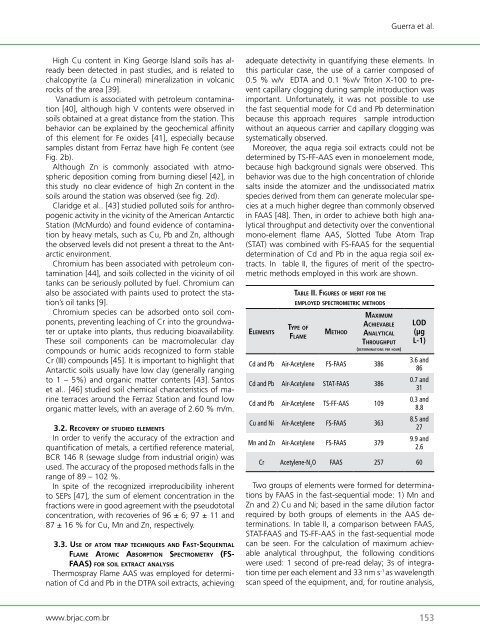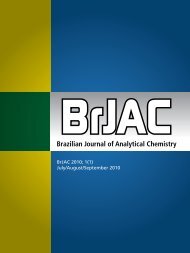Brazilian Journal of Analytical Chemistry - BRJAC - Brazilian Journal ...
Brazilian Journal of Analytical Chemistry - BRJAC - Brazilian Journal ...
Brazilian Journal of Analytical Chemistry - BRJAC - Brazilian Journal ...
You also want an ePaper? Increase the reach of your titles
YUMPU automatically turns print PDFs into web optimized ePapers that Google loves.
High Cu content in King George Island soils has already<br />
been detected in past studies, and is related to<br />
chalcopyrite (a Cu mineral) mineralization in volcanic<br />
rocks <strong>of</strong> the area [39].<br />
Vanadium is associated with petroleum contamination<br />
[40], although high V contents were observed in<br />
soils obtained at a great distance from the station. This<br />
behavior can be explained by the geochemical affinity<br />
<strong>of</strong> this element for Fe oxides [41], especially because<br />
samples distant from Ferraz have high Fe content (see<br />
Fig. 2b).<br />
Although Zn is commonly associated with atmospheric<br />
deposition coming from burning diesel [42], in<br />
this study no clear evidence <strong>of</strong> high Zn content in the<br />
soils around the station was observed (see fig. 2d).<br />
Claridge et al.. [43] studied polluted soils for anthropogenic<br />
activity in the vicinity <strong>of</strong> the American Antarctic<br />
Station (McMurdo) and found evidence <strong>of</strong> contamination<br />
by heavy metals, such as Cu, Pb and Zn, although<br />
the observed levels did not present a threat to the Antarctic<br />
environment.<br />
Chromium has been associated with petroleum contamination<br />
[44], and soils collected in the vicinity <strong>of</strong> oil<br />
tanks can be seriously polluted by fuel. Chromium can<br />
also be associated with paints used to protect the station’s<br />
oil tanks [9].<br />
Chromium species can be adsorbed onto soil components,<br />
preventing leaching <strong>of</strong> Cr into the groundwater<br />
or uptake into plants, thus reducing bioavailability.<br />
These soil components can be macromolecular clay<br />
compounds or humic acids recognized to form stable<br />
Cr (III) compounds [45]. It is important to highlight that<br />
Antarctic soils usually have low clay (generally ranging<br />
to 1 – 5%) and organic matter contents [43]. Santos<br />
et al.. [46] studied soil chemical characteristics <strong>of</strong> marine<br />
terraces around the Ferraz Station and found low<br />
organic matter levels, with an average <strong>of</strong> 2.60 % m/m.<br />
3.2. re c o v e r y o f studIed elements<br />
In order to verify the accuracy <strong>of</strong> the extraction and<br />
quantification <strong>of</strong> metals, a certified reference material,<br />
BCR 146 R (sewage sludge from industrial origin) was<br />
used. The accuracy <strong>of</strong> the proposed methods falls in the<br />
range <strong>of</strong> 89 – 102 %.<br />
In spite <strong>of</strong> the recognized irreproducibility inherent<br />
to SEPs [47], the sum <strong>of</strong> element concentration in the<br />
fractions were in good agreement with the pseudototal<br />
concentration, with recoveries <strong>of</strong> 96 ± 6; 97 ± 11 and<br />
87 ± 16 % for Cu, Mn and Zn, respectively.<br />
3.3. use o f a t o m t r a p t e c h n Iq u e s a n d fa s t-se q u e n t Ia l<br />
fl a m e at o m Ic absorptIon spectrometry (fsfaas)<br />
f o r s o Il e x t r a c t a n a l y s Is<br />
Thermospray Flame AAS was employed for determination<br />
<strong>of</strong> Cd and Pb in the DTPA soil extracts, achieving<br />
www.brjac.com.br<br />
adequate detectivity in quantifying these elements. In<br />
this particular case, the use <strong>of</strong> a carrier composed <strong>of</strong><br />
0.5 % w/v EDTA and 0.1 %v/v Triton X-100 to prevent<br />
capillary clogging during sample introduction was<br />
important. Unfortunately, it was not possible to use<br />
the fast sequential mode for Cd and Pb determination<br />
because this approach requires sample introduction<br />
without an aqueous carrier and capillary clogging was<br />
systematically observed.<br />
Moreover, the aqua regia soil extracts could not be<br />
determined by TS-FF-AAS even in monoelement mode,<br />
because high background signals were observed. This<br />
behavior was due to the high concentration <strong>of</strong> chloride<br />
salts inside the atomizer and the undissociated matrix<br />
species derived from them can generate molecular species<br />
at a much higher degree than commonly observed<br />
in FAAS [48]. Then, in order to achieve both high analytical<br />
throughput and detectivity over the conventional<br />
mono-element flame AAS, Slotted Tube Atom Trap<br />
(STAT) was combined with FS-FAAS for the sequential<br />
determination <strong>of</strong> Cd and Pb in the aqua regia soil extracts.<br />
In table II, the figures <strong>of</strong> merit <strong>of</strong> the spectrometric<br />
methods employed in this work are shown.<br />
ElEmEnts<br />
taBlE ii. fi g u rE s o f m E r i t f o r thE<br />
EmPloyEd sPECtromEtriC m E t h o d s<br />
tyPE o f<br />
fl a m E<br />
mE t h o d<br />
ma x i m u m<br />
aC h i E v a B l E<br />
an a l y t i C a l<br />
th ro u g h P u t<br />
(d E t E r m i n a t i o n s PEr h o u r)<br />
Cd and Pb Air-Acetylene FS-FAAS 386<br />
Cd and Pb Air-Acetylene STAT-FAAS 386<br />
Cd and Pb Air-Acetylene TS-FF-AAS 109<br />
Cu and Ni Air-Acetylene FS-FAAS 363<br />
Mn and Zn Air-Acetylene FS-FAAS 379<br />
Guerra et al.<br />
LOD<br />
(μg<br />
L-1)<br />
3.6 and<br />
86<br />
0.7 and<br />
31<br />
0.3 and<br />
8.8<br />
8.5 and<br />
27<br />
9.9 and<br />
2.6<br />
Cr Acetylene-N 2 O FAAS 257 60<br />
Two groups <strong>of</strong> elements were formed for determinations<br />
by FAAS in the fast-sequential mode: 1) Mn and<br />
Zn and 2) Cu and Ni; based in the same dilution factor<br />
required by both groups <strong>of</strong> elements in the AAS determinations.<br />
In table II, a comparison between FAAS,<br />
STAT-FAAS and TS-FF-AAS in the fast-sequential mode<br />
can be seen. For the calculation <strong>of</strong> maximum achievable<br />
analytical throughput, the following conditions<br />
were used: 1 second <strong>of</strong> pre-read delay; 3s <strong>of</strong> integration<br />
time per each element and 33 nm s -1 as wavelength<br />
scan speed <strong>of</strong> the equipment, and, for routine analysis,<br />
153



